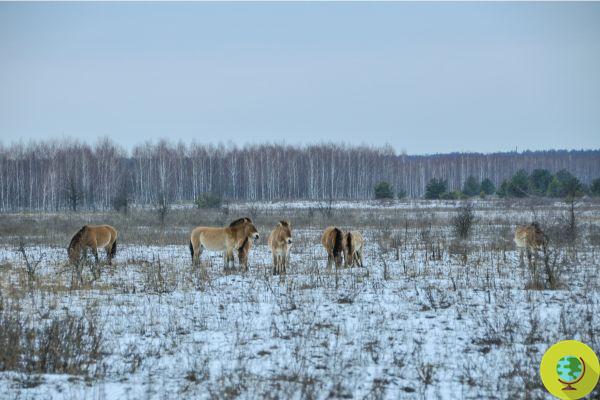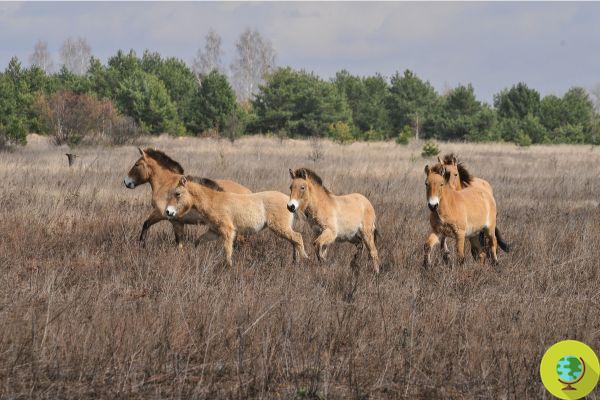Przewalski's horses, reminiscent of cave paintings, roam the exclusion zone surrounding the nuclear power plant. And they are a real mystery
He is about to end up run over, his mother saves himPrzewalski's horses, whose primitive appearance resembles those of rock paintings, roam the exclusion zone surrounding the nuclear power plant. And they are a real mystery
Originally they lived only in Asia, they thrive there for thousands of years but for some time i Przewalski's wild horses they live in the exclusion zone surrounding the Chernobyl nuclear power plant. Their survival is a real mystery that fascinates scientists.
Exactly 34 years ago, the terrible accident took place at the Ukrainian nuclear power plant. The effects were devastating and are still felt today. After the disaster, 350.000 people were evacuated and one was born exclusion zone 4700 sq km between Ukraine and Belarus.
Initial forecasts indicated that, due to radioactive contamination, the area would remain uninhabitable for over 20.000 years, turning into a "desert" where life would no longer be possible. Three decades after the disaster, a diverse and rich animal community lives in Chernobyl. In fact, a large number of threatened species at national and European level have found refuge in the exclusion zone, where humans cannot access but are the Przewalski's wild horses to intrigue scientists.
The mystery of Przewalski's horses
The existence of wild horses in the steppes of Asia was known in the West from the 15th century but such creatures were formally described only in 1881 when a skull and skin of a specimen were identified by the Russian colonel Nikolai Przewalski. Thus it was that the horses known as takhi ("sacred") in Mongolia were renamed Przewalski's horses (Equus ferus przewalski).
For a long time they were considered to be the only wild horses in the world but it was later shown that they were descended from the first horses tamed by the Botai people in northern Kazakhstan, dating back 5.500 years.
In the days of Colonel Przewalski, these wild horses were already rare in the steppes of Mongolia and China. Overgrazing and human hunting for food have caused its eventual decline. The last specimen in the wild was observed in the Gobi desert in 1969.
The captive population was not in a rosy situation either. In the 50s, only 12 specimens populated European zoos. But it was from the latter that a breeding program began which, in spite of itself, managed to save the species from extinction.

© Shutterstock / Maryna Shkvyria
Today the population reaches 2.000 individuals. Several hundred live in freedom in the steppes of Asia, other areas in Europe. Among them, many populate the Chernobyl exclusion zone.
There were no Przewalski horses at the time of the accident at the nuclear power plant. In 1998, Ukrainian zoologists released 31 horses to the area with the aim of grazing them on foliage and reducing the risk of fires.
After 5 years, the high birth rate has brought the population to 65 individuals. Unfortunately, poaching between 2004 and 2006 decimated the population. In 2007 there were only 50 of them but today in Chernobyl it is possible to find over a hundred.

© Shutterstock / Maryna Shkvyria
How have they survived in a radioactive area for decades?
The case of Przewalski's horses reflects once again that, in absence of man, Chernobyl has become a "paradise" for wildlife. This should lead us to reflect on the impact of human presence on natural ecosystems.
Without human activity, even in the presence of radioactive contamination, the fauna thrives.
The protection measures have meant that just 20 years after his arrival in Chernobyl the number of wild horses has multiplied by five. The most recent census, conducted by local scientists in 2018, revealed that around 150 animals live in the Ukrainian part of the exclusion zone. Horses are grouped into 10-12 herds, as well as two groups of males and some solitary individuals. In 2018, 22 foals were born. Some have moved further north and have already settled in Belarus.
Cameras installed throughout the exclusion zone have shown that, despite being a steppe-related species, these horses use the forest very frequently in Chernobyl. This includes the famous "red forest", one of the most radioactive areas on the planet.
In any case, we need to better understand the mechanisms that allow fauna to live in areas with radioactive contamination. There are still many unanswered questions. Are living organisms in Chernobyl exposed to less radiation than expected? Does this exposure cause less damage? Do organisms have more effective mechanisms than expected to repair cellular damage caused by radiation?
“To answer these questions we need more studies. In September, we hope to start working with Przewalski's horses in Chernobyl, trying to unravel the mysteries that make this species and many others thrive in the exclusion zone, "said Germán Orizaola, researcher with the Ramón y Cajal program at the University of Oviedo. .
At the moment the only certainty about the survival of horses in the exclusion zone concerns the absence of man.
Sources of reference: El Pais, Smithsonian
READ also:
Chernobyl: animals have genetically 'self-modified' (the new radioactivity map)
Nature returns to populate Chernobyl: after the wolves you can also spot eagles, minks and otters
Moose, roe deer, wild boar: animals repopulate Chernobyl after the nuclear disaster (PHOTO) anima


























